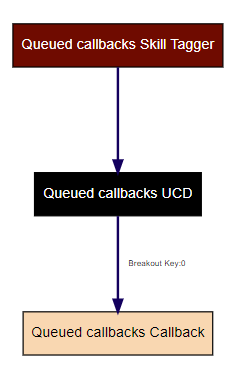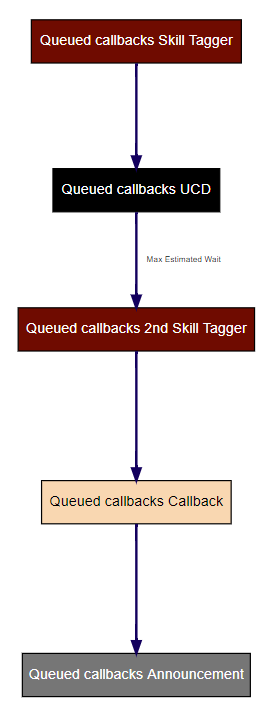How can I enable a caller to hang up their phone but remain, virtually, in a queue?
If you want to enable callers to hang up their phone but remain, virtually, in a queue, configure your interaction plan to use callbacks. Configure your plan to set up a callback when a caller either voluntarily breaks out of a queue or in any other queue-breakout scenario. When a suitable agent becomes available, ContactWorld initiates an outbound call from that agent to the caller.
To configure virtual hold, perform the following tasks:
Create a Callback applet.
A Callback applet contains just one field, Next Applet. Optionally select the applet that ContactWorld routes the call to after the callback is set up. For information about Callback applets, see Callback applet.
If the subsequent applet or applets have not completed by the time ContactWorld initiates the callback, the caller might still be connected to the original call. In this situation the callback will fail. ContactWorld will not attempt a later callback.When ContactWorld routes a call through the Callback applet, the applet sets up an outbound call to the caller. ContactWorld initiates the callback when a suitable agent becomes available.
Configure a breakout in an Automatic Call Distributor (ACD) applet in your interaction plan.
The ACD applet must behave as a skills based router, that is, a Universal Contact Distributor (UCD) applet. For information about UCD applets, see Automatic Call Distributor (ACD) or Universal Contact Distributor (UCD) applet.The breakout must route the call to the Callback applet. For information about UCD applets and configuring breakouts, see Configuring breakouts.
Most simply, you can configure the breakout to route the call directly to the Callback applet. The Callback applet maintains both the caller's position in the queue and all skills associated with the call. ContactWorld initiates the callback, therefore, at approximately the same time that the original call would have been answered. ContactWorld assigns the call to the same agent who would have answered the original call. For an example of this configuration, see Basic virtual hold example using a voluntary breakout.
Alternatively, you can configure the breakout to route the call to one or more other applets, before the Callback applet. If one or more of the intervening applets change any routing parameters, ContactWorld may initiate the callback earlier or later than the call might have originally been routed to an agent. For example, you could route the call through a Skill Tagger applet that removes skills. Removing skills is likely to increase the chance that an appropriate agent is available to make the callback sooner. For an example of this configuration, see Advanced virtual hold example using an estimated wait time breakout.
Example interaction plans with queued callbacks
Basic queued callbacks example using a voluntary breakout
In this example, when an inbound call arrives in ContactWorld, the following events take place:
- ContactWorld routes the inbound call through a skill tagger applet (Virtual hold Skill Tagger). This applet tags the call with French and Spanish skills.
- ContactWorld then routes the call to a UCD applet (Virtual hold UCD).
The UCD applet has a single voluntary breakout option. - If the caller presses 0 on their telephone keypad, ContactWorld routes the call to a Callback applet (Virtual hold Callback). ContactWorld sets up a callback for when calls in front of this call in the queue have been routed to agents and when an agent with French and Spanish skills becomes available.
Advanced queued callbacks example using an estimated wait time breakout
In this example, when an inbound call arrives in ContactWorld, the following events take place:
- ContactWorld routes the inbound call through a skill tagger applet (Virtual hold Skill Tagger). This applet tags the call with French and Spanish skills.
- ContactWorld then routes the call to a UCD applet (Virtual hold UCD).
The UCD applet has an estimated wait time breakout time of 300 seconds (5 minutes). - If the estimated wait time exceeds 5 minutes, ContactWorld routes the call to the configured breakout applet. The breakout applet is another Skill Tagger applet (Virtual hold 2nd Skill Tagger). This applet removes all skills. ContactWorld uses the call's new skill requirements to determine which agent or agents can handle the call and the call's new position in the queue.
- ContactWorld routes the call to a Callback applet (Virtual hold Callback). ContactWorld sets up a callback for when calls in front of them in the UCD queue have been handled and an appropriate agent becomes available.
- ContactWorld routes the call to an announcement appplet (Virtual hold Announcement). This applet thanks the caller for setting up the callback. This announcement must be complete or the caller must hang up before the callback is initiated, otherwise the callback fails.


